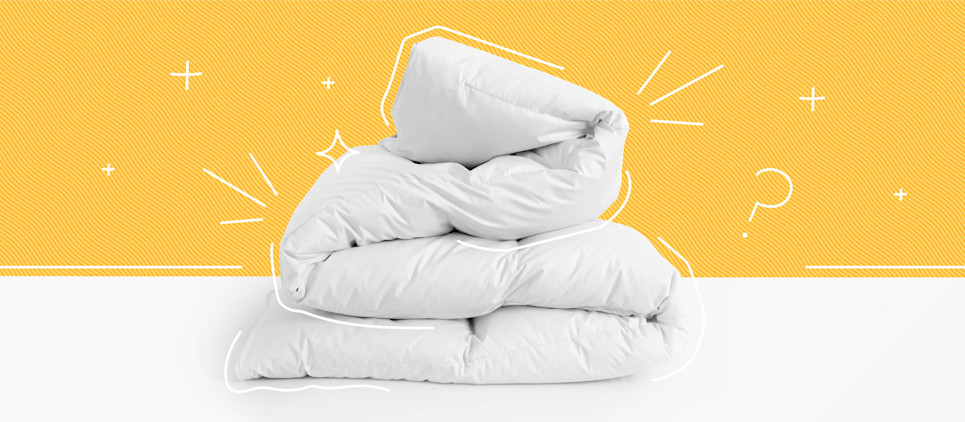What is a duvet? Learn all about this bedding essential
The average person will spend 33 years in bed over the course of a lifetime. That figure might make you want to put some extra thought into how you design your bed. One of the decisions that can affect not only the cost of putting together your perfect bed—but also the bed’s temperature, washability, fluffiness, and aesthetic—is whether to buy a duvet or comforter.

Table of contents
What is a duvet?What is a duvet cover?Is a duvet the same thing as a comforter?Duvet vs. comforter: How to decideWhat is a duvet?
A duvet is a bed covering that is filled with down feathers, synthetic down stuffing, or a mix of both. Duvets have two components: a duvet insert and a duvet cover. The insert—which is the blanket piece—is usually white in color, and is a bit of an ordeal to clean. It’s meant to be paired with a removable and washable duvet cover.
What is a duvet cover?
Duvet inserts slip into covers that close with snaps, zippers, or ties. A duvet cover protects the duvet insert from body oils, spills, and stains because it is removable and machine washable. While a duvet itself is generally quite plain, duvet covers are sold in a wide variety of materials, patterns, and colors.
Is a duvet the same thing as a comforter?
Duvets and comforters are very similar, but the main difference between the two is whether the outer layer is removable. A comforter is often sold in a pattern or color and not meant to be used with a separate cover, while a duvet is meant to be paired with a duvet cover.
Another difference is the filling. Often, a comforter is filled with synthetic fiber, while a duvet is more likely to be filled with feathers, especially down, as the name duvet is derived from French, meaning “down comforter.”
Additionally, comforters are often sold as part of “bed in a bag” sets, which include sheets and pillowcases as well as the comforter itself. On the other hand, a duvet is often sold on its own, requiring the buyer to purchase a separate duvet cover set, which usually includes the cover and two pillow shams.

Duvet vs. comforter: How to decide
There are pros and cons to both duvets and comforters. Here are some considerations when deciding which is right for you.
A duvet is a smart choice for you if:
You pay attention to design trends. Because a duvet cover is removable, you can keep your duvet and buy a new duvet cover as your tastes change. The insert is the expensive part, and it should last you years, if not decades.
You have pets, children, or love breakfast in bed. Being able to easily wash a duvet cover will save you from figuring out how to get your bedding dry cleaned.
You have patience for making the bed. Anyone who’s ever owned a duvet and cover knows the specific frustration of trying to stuff the insert inside the cover. If you simply cannot deal with this, try a comforter.
You live in a cold climate. Many duvets are made with goose down, which is a natural thermal insulator, keeping you warm but not sweaty.
You hate a top sheet. A duvet cover does double-duty as a top sheet, so if you always end up tangled in or separated from that top layer, go for a duvet. You can pop it right on top of a fitted sheet and call it a day.
You’re investing in your bed long-term. Given the cost of purchasing a duvet with an expensive filling like down, plus the fact that the sheet set and duvet cover set are generally sold separately, the duvet plus cover route tends to be a bit pricier. But if you’re putting down roots, it can be well worth the expense.
A comforter is a smart choice for you if:
You know your taste—and it’s unlikely to change. Again, comforters tend to come pre-designed with a print that matches the rest of the bedding set. If you think your bedroom decor will stay consistent, a comforter can be a good choice.
You have little patience for laundry. Avoid the annoyance of monitoring when you last washed your duvet cover as well as how to successfully slip it over the insert by buying a comforter.
You’re budget-conscious. Because they tend to be made with more affordable materials and come in pre-packaged sets, comforters are overall a less expensive investment than a duvet and cover.
You love to layer. Because they aren’t easily washable, comforters are best paired with top sheets. And if you live in a colder climate, you might need a winter knit blanket or quilt to pair with the comforter to trap heat in lieu of down feathers.
While it may seem inconsequential, the type of bedding you purchase can have a big impact on your long-term well-being. Lack of sleep has been correlated with memory issues, weakened immunity, high blood pressure, and more. Choosing that perfect mix of hot and cold, fluffy and flat, simple or decorative is a small but important detail.
Bungalow is the best way to live with roommates. We offer private rooms in shared homes that are more affordable than living alone in the same neighborhood. Common areas come furnished, and wifi, utilities, and monthly cleaning are all set up when you move in so that coliving is seamless. Find a Bungalow near you.
Ready to find your next home?
Move-in ready homes and a built-in community so you can feel at home, together — wherever you are.
Suggested articles



